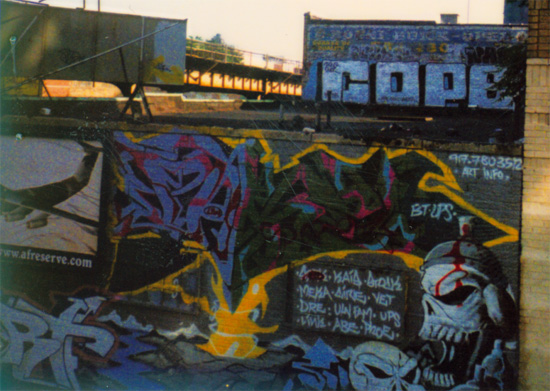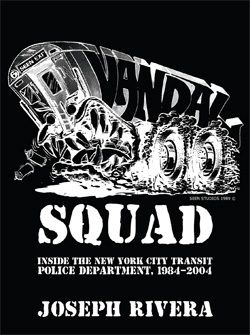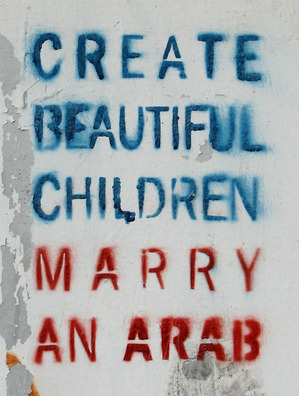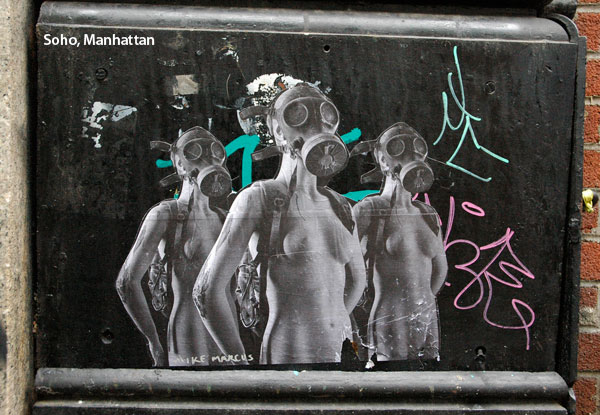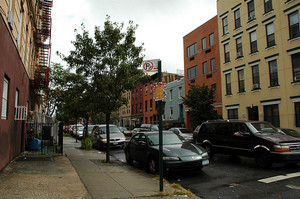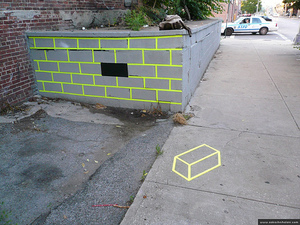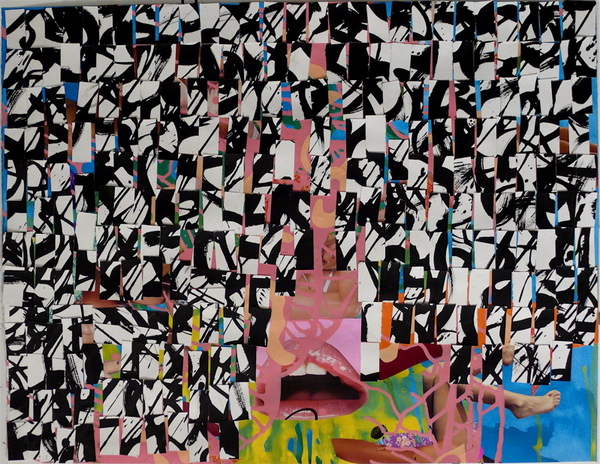This is an archive of the ArtCat Zine, 2007-2009. Please visit our new project, IDIOM.
Recently by Hrag Vartanian
Judging by the thousands of books that have emerged over the years about graffiti you'd be forgiven for forgetting that it's an art form that thrives on its illegality, but with the recent release of Vandal Squad by powerHouse books that me be about to change. Former NYPD Vandal Squad cop Joseph Rivera has written a biography of sorts about his twenty years on the force (1984-2004) through the eyes of a native who chose to enforce the law against these artistic rebels. It's not your typical graffiti book but then Rivera isn't your typical author either.
Rivera's story begins with his admission that as a kid he would watch the trains go by decked out in graffiti and in the eighth grade he "caught my first and only tag on a city bus that ran on Tremont Avenue." It was a period when "materpieces, blockbusters and throw-ups totally covered the outside of the trains, and marker tags filled the inside of the cars." He admits that he "would look upon some of those pieces with awe" but he ended up in the Transit Squad in 1984 since he thought "this sure beats working at the deli."
His prose is simple but comes across as authentic and honest. He doesn't glorify the Vandal Squad but he has a deep respect for a police force that didn't always return the favor. First serving as a cop in the Transit Service and then as an officer in a unified NYPD, Rivera was perpetually overlooked for promotions. He suggests possible explanations for this but we are left feeling that the real reason may have ultimately eluded him.
During his 20 year journey as a Vandal Squad cop he meets characters of all types, including cops he clicked with and others he didn't. He writes about graffiti writers who stopped because of the threat of criminal prosecution and others who continued no matter the consequences. Some of the stories are interesting windows into the lives of these urban artists but others meander and would've benefited from careful editing.
But even among his laundry list of war stories, which includes run ins with everyone from the KGKASS Crew to the YKK Crew and most famously REVS, there are passing thoughts that give us insight into the essence of graffiti. When Rivera "collared" graffiti pioneer STAY HIGH 149 he discovered that the artist -- the author calls them vandals -- was a gentleman. "He gave us no problems whatsoever," Rivera writes. "He told us, 'I beat the drugs but I can't beat graffiti.'"
Last fall, I encountered odd black and white images of nude women donning gas masks around the Flickrstreams of my New York contacts and shortly thereafter started spotting them on the streets of lower Manhattan and northern Brooklyn. They seemed out of place in that they were absurd and seemed to have appeared on the streets of the city overnight.
I finally spotted the artist's name on the bottom of one piece in Bushwick written as Mike Marus, which I later discovered was actually Mike Marcus. The alienated figures are powerful and poignant and from someone who obviously had something to say, though at first I wasn't sure exactly what.
After a little digging I discovered that Marcus is a Brit of Jewish heritage who moved to Israel in 2000 and has since moved back to London. His confrontation with the realities of the Second Intifada and Israeli rights abuses against Palestinians galvanized his art. Filled with anger, he took his message to the street and started producing public unsanctioned work. His early work first focused on posting images of West Bank violence on the streets of Israel and then he shifted gears and began to incorporate more penetrating attacks at the essence of Zionism, namely, the purity of the Jewish people and the sanctity of Israel as an idea.
The Rebranding Israel project doesn't pull any punches and its brash imagery portrays a side of Israel many Zionists refuse to see. Marcus has also created a series of art works where he gassed himself with CS gas (tear gas) and photographed the results. As the artist points out on his blog the meaning of his self-gassing was related to his history as a Jew and the current ironies of the Palestinian/Israeli conflict (emphasis mine):
CS is the most common form of tear gas. Its use by military forces is forbidden under the Geneva Convention and the Chemical Weapons Convention of 1997. However during the first year of the Al-Aqsa intifada alone the Israeli Defense Forces used 120,000 tear gas grenades against Palestinians as a form of racially motivated collective punishment.Although the Jews own encounter with the gas chambers makes the use of chemical warfare notable for its irony, it is only one example of the many human rights abuses exercised by Israel during its 41 years of military occupation.
To encourage awareness of the continuing violations enacted by my people against a weak and vulnerable minority and to register my protest, as an ethnic Jew against the injustices carried out in my name, I exposed myself to CS gas and photographed the results.
I had no other way to cry.
Marcus seeks to burst the "bubble" that engulfs life in the great Jewish state and his recent street work continues the trend of pushing that envelope. Within this context we see the cloud of dread that hangs above his gas mask donning mannequins, seemingly caught unawares at the start of an apocalyptic new season. She looks like she we just stepped out of the Garden of Eden and she stands silently watching us eat an apple laced with some hazardous material.
About the mannequins, Marcus has this to say (via his blog):
She is all of us:Dirty and fatigued by a world which expects too much and doesn't give enough in return. Guilty because in a dark place she keeps the knowledge that society is no more than a collection of of her. There is nobody else to blame so in silence she stands and watches.
Hiding behind a mask of her own making she protects herself from what?
...
She fears this week's new collective anxiety. Islam? Terror? Dark skin? She can't remember the difference anymore.
Her bag is packed, back is covered but in the end she stands nude and accountable in a crumbling city.
Marcus describes this female figure as a metaphor for some sort of traumatized collective consciousness. There is an air of science fiction to his work, as if he is projecting his imagery into a bizarre future. Elsewhere on his blog meanwhile he makes a provocative statement about his work based on Israeli issues:
Its easy to provoke a reaction in Israel. All you need to do is tell the truth and watch everyone flip out.
Intrigued by his aggressive imagery, I spoke to Marcus online in an effort to understand his work.
A Maze
Celso, Infinity, Stikman, LAII & Cbeauty
Factory Fresh - 1053 Flushing Avenue, Brooklyn NY
14 November - 2 December 2008
One of the biggest obstacles for street artists trying to make a living is the transition from street to the gallery context. It may be considered inauthentic to restrain your creativity to the confines of a commercial gallery system, but an artist (street or otherwise) has to make a living. Sometimes it works, like Judith Supine's flawless transition with his Dirt Mansion show at English Kills earlier this year. Other times is doesn't; think London street art gallery Lazarides' New York exhibit in October at the corner of Bowery and Houston. The former relied on and succeeded with a zest for experimentation and over-the-top theatrics while the latter -- even though the venue had been long established as a "street art" gallery -- relied on an a gritty, industrial exterior to communicate a "street" vibe or framework to the exhibition -- and it failed. Treating the street as mere ornament doesn't do justice to the art but I'm guessing that most artists (and galleries) who do are too blinded by dollars, euros or yen to really give a shit.
The latest batch of artists to focus on street to gallery experimentation is a group showing at Bushwick's Factory Fresh. Some of them belong to the Endless Love Crew who had a show earlier this year called Post No Bills which was mounted on scaffolding in Long Island City. They seem eager to try something new and A Maze, their new exhibition, succeeds at recreating the energy of the street in the Flushing Avenue space.
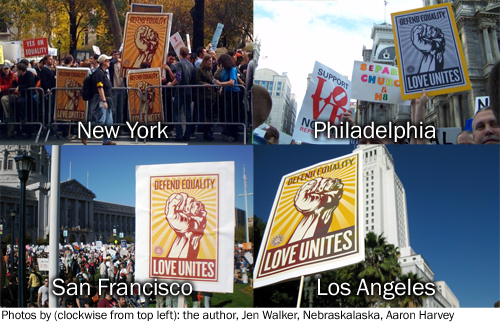
Re:Public
Branding Equality & Taking It to the Street:
An Interview with Aaron Harvey & His Work in the Anti-Prop 8 Movement
Since the crushing passage of LGBT rights activists and their allies have been protesting the vote that could invalidate some 18,000 marriages. If street artists have indeed played a seminal role in this year's election -- think Shepard Fairey & Obama -- they have yet to raise their voices in the anti-Prop 8 campaign... well, that was until this past weekend.
Released on Friday, November 13 via Towleroad, Obey Giant and the anti-Prop 8 campaign's Join the Impact website, a new Fairey poster called Defend Equality was already part of every major protest the following day at marriage equality rallies across the country.
Defend Equality is a striking graphic that is informed, like many of Fairey's works, by early Soviet design, American social realism and imagery associated with the labor movement. Dominated by a clenched fist, the poster shies away from the words "gay" or "marriage" in order to promote the fight against Prop 8 as a universal human rights issue.
What people may not realize is that Fairey's image was heavily inspired by designer Aaron Harvey. I caught up with Aaron online to discuss his image and the role street art plays in his work.
Why did Towleroad mention that you influenced Fairey's Defend Equality image? What exactly was your involvement?
F.A.I.R. and Join the Impact approached Shepard Fairey and asked him to do an original piece for the upcoming rallies. They were looking for something salient and universal. They had shown him a design that they really liked, my poster, and he said something to the effect of: "it's amazing as is, here's my take on it." So, it was an interesting collaboration of sorts, especially because he, along with people like Sam Flores and Urban Medium, influence me.
If you live in New York, love street art and support Barack Obama, this year's U.S. Presidential campaign was bliss. The fact that street artists tend to lean Democratic doesn't really surprise anyone, but the Obama campaign's endorsement of street art probably does. This isn't the first time a politician has been the muse or patron of the art of the streets; Shepard Fairey did a Ralph Nader poster in 2000 and Howard Dean tried to incorporate graffiti in his 2004 Presidential run, but this may be the first time a Presidential contender has incorporated the urban art form as an integral asset to his or her campaign.
I've gathered some of the best images from this Presidential season which is featured in a slideshow below.
Next week expect an essay about how Election 2008 has impacted and may have changed street art forever.
Special thanks to Jake Dobkin, Billi Kid, Thundercut and others for special permission to use their images for this photo essay.
From Smack Mellon to the Triangle Arts Workshop, from artist studios to loading dock installations: DUMBO was decked out for its role as one of Brooklyn's premier art festivals: the 2008 Art Under the Bridge weekend.
While I got to see a healthy chunk of what was on display, I kept overhearing people talk about cool things I missed like the performance artist who bartered objects with the public or the artist who unfurled a blanket on the rocky shores of the East River. It was a rainy day under the Manhattan Bridge but no one seemed to notice.
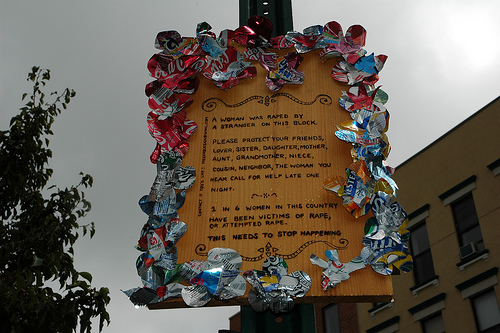
At a nondescript corner of Meserole and Humboldt in the eastern section of Williamsburg stands an unusual and what seemed to me consciously-folksy sign bolted to a no parking sign. It reads:
"A woman was raped by a stranger on this block. Please protect your friends, lover, sister, daughter, mother, grandmother, niece, cousin, neighbor, the woman you hear call for help late one night. 1 in 6 women in this country have been victims of rape or attempted rape. This needs to stop happening."
Framing the message, which is burned into a flat piece of wood, is a dense border of flowers made out of aluminum cans. Also on the work is an email address and a shy invitation to reach out to the sign's creator.
I wrote the individual to learn more about this work, a strange meeting of micro-monument, public service announcement and folk art. I received a response from the sign's maker the next day and she agreed to speak to me over email but not in person because she explained: "My case is still in court and i don't want to jeopardize my anonymity."
The circumstances of the crime that was committed against her is chilling. She told me that one day on her way home at 2am she was assaulted as she opened her front door. Forced inside, she was held in her apartment for five hours, raped and robbed her assailants let her go the next morning. Follwing is record of our conversation about the art work that aims to raise awareness about the crime of rape and its impact on a community.
Hrag Vartanian: Who are you? Are you an artist?
Anonymous: I am a 26 year old female living in Brooklyn, where I've lived for the past 4 years. I've been in NYC for 8 years now. I came to New York for art school, and have been developing my studio practice since I graduated 4 years ago. I am a sculptor and installation artist.
HV: Do you consider the sign in north Brooklyn a work of street art?
A: I've honestly never made street art before. I admire a lot of street artists but I have never felt that my own work needed or wanted to be in the streets. It's never been part of the dialogue in my work. I suppose the sign is a piece of street art because it's purpose is to directly communicate with the community, and it's about the community. It needs the context of the street to be successful. I don't think it could exist in the same way in the gallery.
HV: Why did you create it?
A: I had heard about and seen the Ghost Bikes installed around the city, and was really inspired by their idea to memorialize a tragedy with street sculpture. You probably know about them: a broken bike is spray painted-white and chained to a street sign near the location of a cyclist's death. So, I thought of making a sign to create awareness of rape occurrences, to make people realize that it can, and has, happened in their neighbor, or to their neighbors.
Editor's note: Re:Public is H.V.'s a new column on ArtCal covering contemporary street art in New York City.
Re:Public, Masters of the Ephemeral
If the world of street art is mercurial then it should come as no surprise that the art of two of downtown's most visible artists are as ephemeral as the urbanscape.
Poster Boy may be new to the game but he has already attracted much attention for his precise mash-ups of advertising and signage. Using a razor, he targets mainstream advertising images which he remixes into funny and absurd commentaries on life, culture and politics. He admits that he has long vandalized posters but more recently his reformatting of corporate propaganda is being honed to cleverly subvert its original message. His Flickr page surfaced only a few months ago and it is definitely provides the easiest access for his hybrid work.
Why does he do it? "I do it for a few reasons," he tells me over email. "A: I can barely afford art materials. B: I don't like the media bombarding me with bullshit everywhere I go. C: I like to see the public react to my work."
Though nothing appears sacred to him, Poster Boy does make a point to target ads that piss him off the most. The only people who seem to take exception to his work tend to be agents of the municipal surveillance industry: the NYPD and MTA workers. He knows that it can be quite jarring for many people to spot a razor-wielding figure on the subway platform but he sees them relax when they realize he's only interested in artistic mayhem.
"I don't want Poster Boy to be about one person. They're never signed, unless you consider the Flickr page my signature, so that any piece can belong to anyone. A lot of people say I'm a sucker for not trying to make money off Poster Boy, but I still feel rewarded. However, I'd like to make a book of the best pieces from '08. Who knows how well that'll turn out?" he says.
Another street artist who has been creating marginal street art works is Aakash Nihalani, who doesn't use a nickname like so many other street talents. He fashions cubes out of colorful tape throughout Brooklyn and Manhattan. He explains why the box appeals to him and why he shies away from variations of his beloved form: "We live in a big city of big boxes with little windows peeking onto other big boxes next to smaller ones, and so on. The shape, the image I employ, is New York. I guess I feel like there's a certain sense of forgotten dimension, a lot of overlooked layers. So I create reminders and portals with the cubes, adding to the urban landscape. It just makes sense."
Suspension: Paintings by Liz Ainslie & Collages by Evan Reehl Ryer
Spazio 522 - 526 West 26th Street, 5th Floor, New York NY
29 May - 15 August 2008
Pictures and words don't always make ideal companions and often make awkward lovers but fortunately for Liz Ainslie and Evan Reehl Ryer they are both visual artists while I am left with the difficult task of writing about these two who seem to mambo (visually anyway) with flair.
Ainslie's work is an odd mixture of Giorgio Morandi's hazy vision and Ad Reinhardt's floating geometry. She has a knack for painting simple compositions which slowly reveal themselves to be complex, moody and sophisticated. Ryer's work is fast, layered and jarring. They look like Henri Matisse collages on crystal meth.
I assume the show's title derives from the feeling of weightlessness in each artist's work; yet that loose airy feeling is clear in Ainslie's art but less certain in Ryer's. There's no self-consciousness in Ainslie's brush. She draws luscious shapes that float in fields of color that are sometimes jarring but more often swim in a sea of brushstrokes and textures. Her latest series -- she calls them "slices" -- are her best yet.
Interview with Street Artist A1one
Henry Street Settlement, Abrons Arts Center
466 Grand Street, LES
July 17 - August 31, 2008
Last Thursday, "Street Slang: The Modern Urban Imagination" opened at the Abrons Art Center of the Henry Street Settlement. Curated by Lois Stavsky, a longtime observer of global cultural trends, the show included a healthy dose of graffiti and street artists from Tel Aviv to New York. Noticeable among those on exhibit was A1one from Tehran, Iran. A pioneer of the Iranian street art scene, this marks his first show in America.
ZINE
HOME
TIPS / COMMENTS
CATEGORIES
CONTRIBUTORS
- Greg Afinogenov
- B. Blagojevic
- Adda Birnir
- Susannah Edelbaum
- Julie Fishkin
- Paddy Johnson
- Jessica Loudis
- Christopher Reiger
- Andrew Robinson
- Peter J. Russo
- Blythe Sheldon
- S.C.Squibb
- Hrag Vartanian

